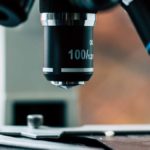
The Benefits of At-Home Genetic Testing For Celiac Disease
At-home genetic testing for celiac disease is a groundbreaking innovation helping people to determine their

At-home genetic testing for celiac disease is a groundbreaking innovation helping people to determine their GlutenID and their likelihood of having or developing celiac disease.
If you suspect you may have celiac disease symptoms or may be likely to develop them, at-home genetic testing provides an ideal way to start your investigation. Working with your doctor to find the cause of your symptoms and starting your journey with an at-home genetic celiac disease test has many benefits.
Many people with no health insurance or insurance that does not cover a wide range of testing find testing for celiac disease a serious financial undertaking. Testing methods for celiac disease are notoriously expensive. The cost alone can be daunting for people who suspect they may have celiac disease.
Testing for celiac disease genetics at home allows you to enter the testing process at a low price point while getting vital information for diagnosis. Although all symptoms should be followed by your doctor, ruling out your genetic risk for celiac disease can save you on further expensive tests and help to speed up the diagnosis of the true cause of your symptoms.
Getting to the cause of any symptoms is often a long process with multiple tests and appointments. It is extremely important that we keep on top of our health appointments and testing but any process we can simplify makes a huge difference in our daily lives.
At-home celiac disease testing arrives at your door, takes minutes to complete, and includes return postage for your sample. The process is quick and helps you start your journey without needing an appointment.
Our health is often a very private part of our lives. We are not always ready to talk to everybody about our health issues and concerns. This is sometimes more accentuated with gastrointestinal problems. These symptoms often illicit misplaced feelings of shame or embarrassment, and people enjoy the privacy of at-home testing options.
Similarly, people who wish to check their celiac genetic risk as they are suffering from unexplained issues such as infertility, fatigue, and nutritional deficiencies enjoy the privacy afforded by the at-home genetic testing before further exploring their suspicions with a doctor.
At-home genetic testing for celiac disease is designed to be as easy and convenient as possible. Targeted Genomics and other testing companies will walk you through the process step by step, so there is nothing to figure out and no questions left unanswered.
Your genetic test will generally include:
Ordering a celiac disease test from Targeted Genomics and other genetic testing companies could not be easier. After ordering online with a credit card, the test is shipped directly to your door within a few days. It is safe, fast, and convenient.
Once you receive your at-home celiac disease genetic test, it is vital to first register the kit with the company. This allows the lab to link your sample with your information. A lab won’t be able to process your sample until the kit is registered in the system.
If you order testing kits for multiple people in your household, you will likely have to register each kit separately. This allows the lab to process each family member’s DNA sample accurately and helps you to keep track of everyone’s results. While opening and registering your kits, keep accurate track of which DNA kit belongs to which person to prevent any accidental swapping of results.
Each swab inside the kit box also has a label to complete. Be sure to fill this in so the lab can identify your sample, matching it to your registered account.
When collecting your sample, swab the inside of both cheeks for 10 seconds. This collects your DNA. Because your DNA is always present and never changes, you do not need to be fasting or have given up gluten before taking a celiac gene test.
After collecting your cheek swab samples, simply place the collection swab back into the tube. Ensure you have filled out the printed label and put your completed swab tube back in its original box. Now it is ready for mailing with the prepaid postage already taken care of.
It is as simple as that. No complicated instructions, time commitments, or dietary requirements. All you need is 5 minutes free during your day to complete your kit. When you have mailed your swab, wait for confirmation that the lab has received your sample and results should be ready within 14 days or less.
Testing for genetic markers for celiac disease is fast and easy. Still, it is vital to interpret the results in a way that will help you on your health journey.
Choosing to work with a company that gives a clear indication of what your results mean is important. The results alone do not have much meaning to most people without good guidance. Targeted Genomics tests for all of the known genetic markers associated with celiac disease, providing a full breakdown of your genetic marker results and your individual likelihood of developing celiac disease and passing on the genes to your children.
If you have concerns about your DNA sample being held by the lab after testing, contact your testing company to find out their policy about DNA storage. At Targeted Genomics, all customer samples are routinely destroyed after testing.
Your genetic celiac disease results will be displayed in an easy-to-understand format in your report. It lets you know exactly which markers you carry and where on the spectrum of risk that places you for developing celiac disease.
When your results are positive for one or more of the genetic markers for celiac disease, it does not mean that you have or will definitely develop the disease.
See your doctor if you have symptoms – If your results are positive and you are symptomatic or suspect you may have developed celiac disease, contact your physician for specific active celiac disease testing. Given the damage that celiac disease can do to our bodies, it is not recommended to wait too long before seeking testing.
Do not give up gluten before celiac disease testing – Even if you think you may have cracked the code to your symptoms after receiving your results, most blood tests to confirm celiac disease will require that you still eat gluten for accurate results. Blood tests look for your body’s active reaction to gluten. This means taking gluten out of your diet prematurely could give you a false negative result, making the diagnosis difficult or confusing.
Seeking further celiac disease testing with your doctor quickly after your positive result means that once diagnosed, you can cut gluten out and begin healing your body. Delaying this process if you have celiac disease can cause damage to your body and make a longer road back to health when you are finally diagnosed.
Keep an open mind about your symptoms – There are many conditions, including gastrointestinal diseases and immune disorders, with symptoms similar to celiac disease. One of the reasons it is important to follow up with blood and biopsy testing is to ensure the diagnosis of celiac disease is correct. If your symptoms are caused by a different condition, removing gluten without further testing may delay your diagnosis and cause harm to your body. At-home testing helps us on the journey of diagnosing and ruling out celiac disease.
If your results are negative for the known genetic markers involved with celiac disease then you have a less than 1% chance of developing celiac disease during your lifetime. This does not mean gluten is not an issue for you or you are not suffering from a different condition.
Do not ignore symptoms when your celiac genetic test is negative – You may suffer from symptoms similar to celiac disease despite your negative test result. In this case, it is vital to consult your doctor to find the cause of your problems.
Many people suffer from gluten allergy and non-celiac gluten sensitivity. Genetic celiac disease tests do not test for either of these issues and cannot tell you whether you have them.
Several gastrointestinal diseases and immune system disorders create symptoms similar to celiac disease. Ruling out a high likelihood of celiac disease is an important step on your journey to wellness.
Diagnosis of celiac disease or similar conditions is always a multi-step process that involves many tests and procedures to confirm exactly what is going on in your body.
At-home genetic celiac disease testing is a cost-effective, convenient, and fast way to start investigating your symptoms and the genetic likelihood of passing on celiac disease genes.
Many people have successfully started their journey to a diagnosis of celiac disease and other conditions by first finding out their genetic GlutenID.
Medical testing innovations are rapidly moving into the future, and genetic testing is at the forefront. The expansion of genetic testing for celiac disease using our DNA allows us to start investigating our symptoms from home, speeding up the time to diagnosis and ultimately reaching our peak wellness.
Make this a live link to our GlutenID SHOP page.
Great explanation of how GlutenID testing can help!
Make this a live link to the GlutenID shop

At-home genetic testing for celiac disease is a groundbreaking innovation helping people to determine their

Virtually everyone prefers a simple cheek swab to an invasive blood test but that’s not

GlutenID® testing was featured in a recent article published by the College of American Pathologists